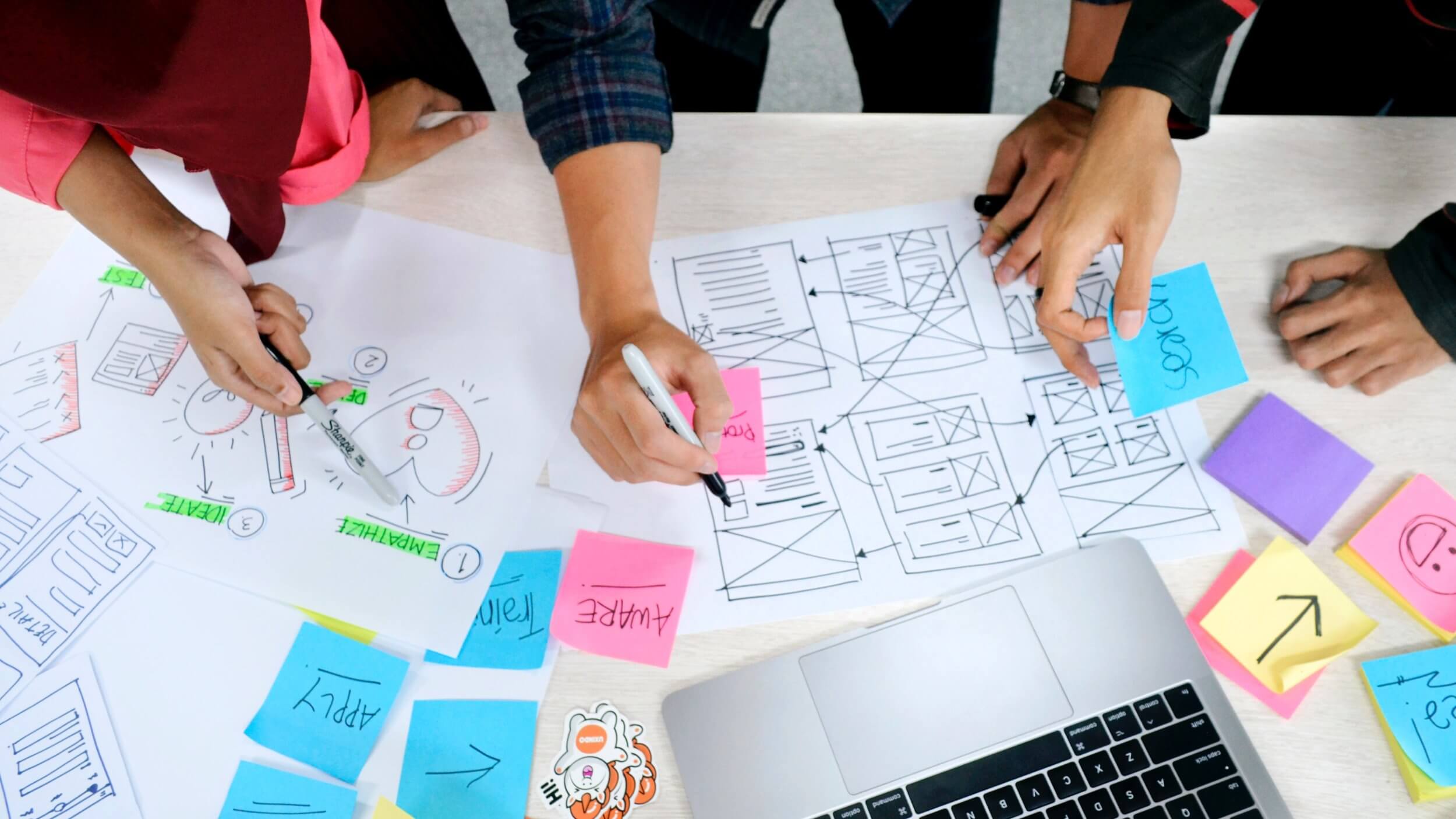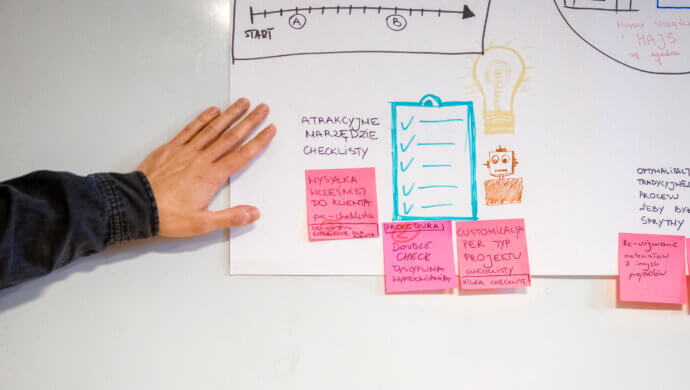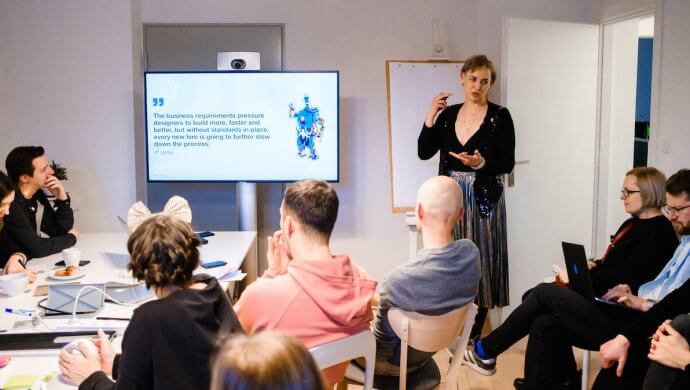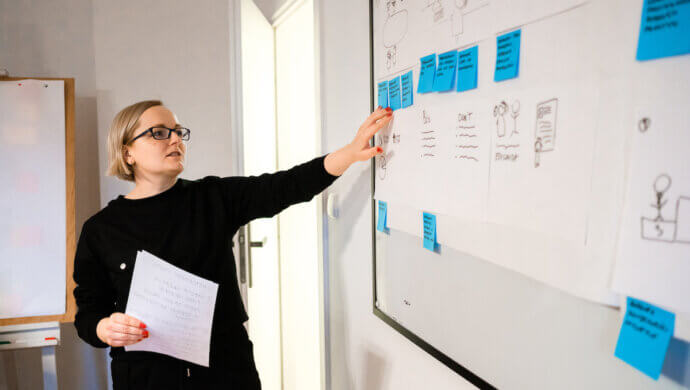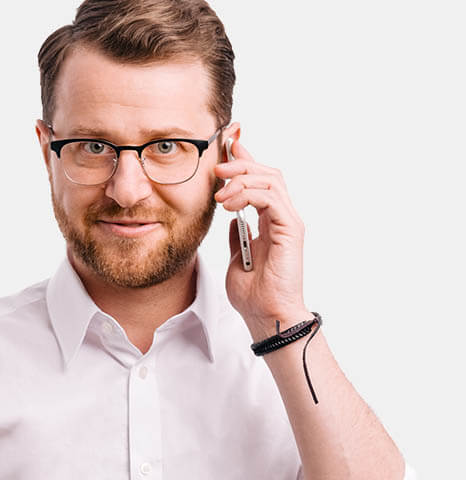Business design is about designing a profitable business. This can be a commercially successful product or a service. To achieve this, business designers use a design thinking approach. This process usually starts with a deep dive into the needs domain and then helps to define the goals and strategies of a business, service, or product by focusing on the verified needs of customers. It also broadens the decision space by bringing in different perspectives (customers, employees, management, business partners, etc.).
It involves understanding the customers, defining the value proposition, prototyping and validating the business model, and determining the appropriate marketing and sales strategies to reach the desired audience. Part of the process should also include defining the unique differentiators for the product (be it quality, design, availability, exclusivity, pricing, etc.).
Business design definition and its value
A well-designed business can help companies develop products and offerings that attract and retain customers. Products, that are robust and hard enough to copy to maintain a competitive advantage. It can also provide a roadmap for growth and success, helping a business stay on track and adapt to changing market conditions. The ultimate benefits of a business design process done right include improved efficiency, increased competitiveness, and greater financial stability.
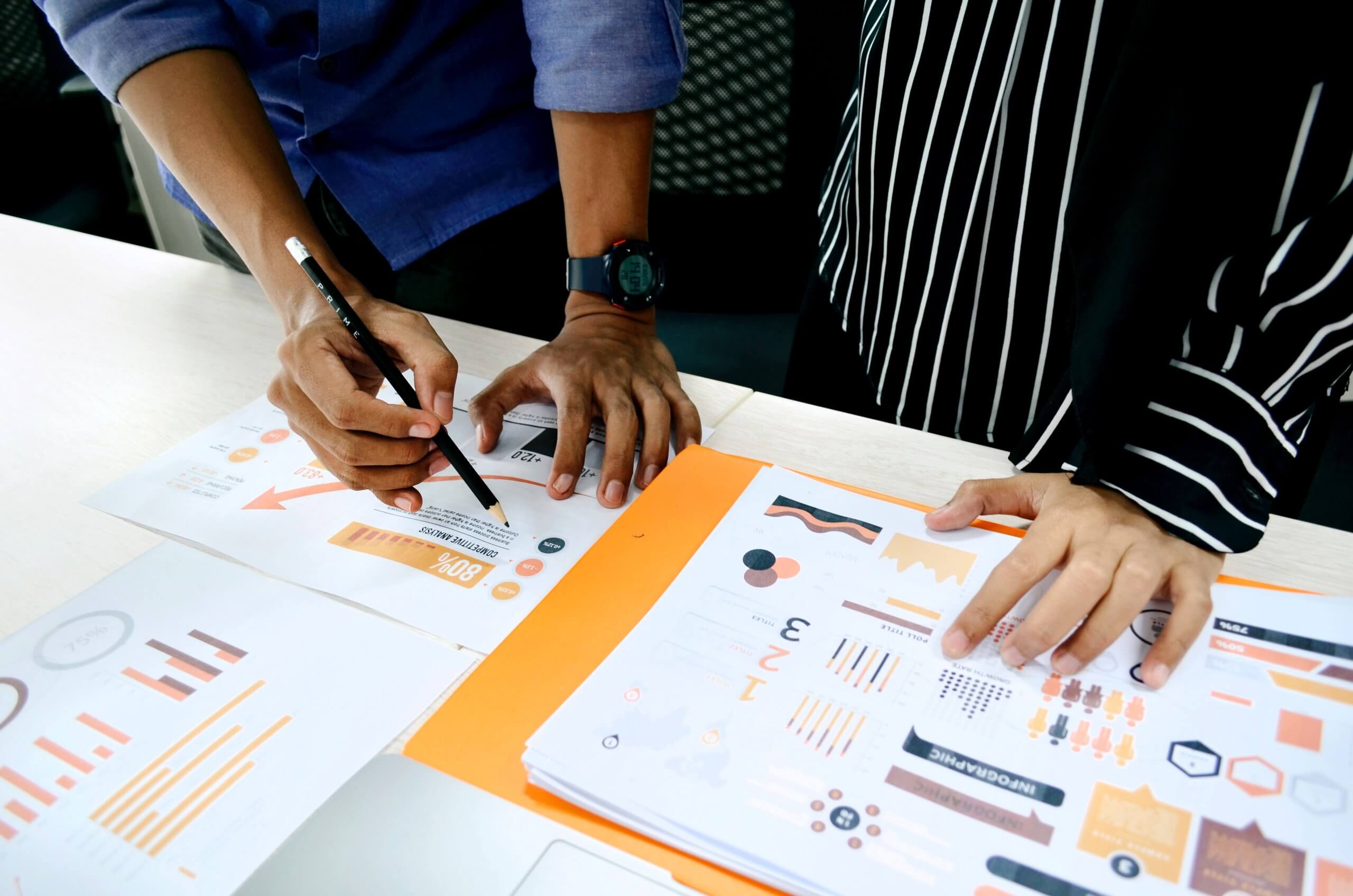
What is actually fresh and quite new about this approach is that it adopts design thinking techniques, which are based on the human-centered design approach and, when applied in a sensible way, can help to create profitable business models and successful products. The key aspect of business design is to bridge the gap between the innovation and creativity of the organisation and the evolving needs of customers.
What a business designer really does and how to recognize one?
Business design is probably one of the hottest topics in business right now, but – as always with new and trendy methods and approaches – it’s not so clear what it’s all about and how to separate the wheat from the chaff in all the jargon and glitter.
Let’s start with the basics: what does a business designer actually do? Typically, a person in a business designer role is responsible for facilitating the process of creating a new business or product and developing the overall strategy and plan for it using design thinking methods or business model innovation. This will include conducting market research (e.g. desk research, in-depth interviews, or ethnographic research) to identify opportunities and assess the competitive landscape, simply to gather insights. It also involves facilitating the process with different stakeholder groups to develop product or service offerings. As a result of the requirements and insights gathered, the business designer will prototype the business model and work closely with product designers to design the first version of the product. Such prototypes may then be validated with potential customers. And sometimes he or she will even provide guidelines and direction for the marketing plan to reach the target market.
Business designers may also be responsible for identifying an organisation’s resources, such as human, technological and financial resources, to support the growth and success of the business. The value that such a person brings comes from combining the design thinking approach with extensive business knowledge.
To recognise a true business designer, look for someone with a strong understanding of different economic models, business principles, and market trends, experience in creating and implementing business strategies, as well as solid experience in design or research.
They should have strong analytical and problem-solving skills and the ability to communicate effectively with stakeholders and team members. Business designers may have a background in business, marketing, or a related field and may hold a degree in business or a related discipline. They should also have relevant experience in a business, consulting, or management role, or have completed training or certification in business design or strategy. This business knowledge is essential to understand the deep structures of the business and to have meaningful conversations with the board and managers.
And since we’re talking about the design thinking approach, it’s also necessary to have a product design or service design background or previous experience in a design role. That’s why experience designers or user researchers make good business designers. At EDISONDA, our core team of business designers comes from the design field (research and design roles), providing a unique mix of knowledge and experience in the design process (e.g. design thinking toolset, human-centred design process).
When hiring a business designer, look for both design and research experience and a good understanding of the business world.
Where does the need for business design come from?
The appetite for such an approach has been driven by the complexity of running a business and the need to have a clear plan to guide decision-making and allocate resources effectively.
There are many business challenges facing organisations and a creative approach is needed to address them. In addition, we see a lot of enthusiasm for launching new products or businesses even within the parent organisation (e.g. corporate venture efforts and living labs units), but very often these ideas fail or are not given enough time and support to be properly tested.
Many start-ups that start as ideas also need business design support to ensure that their product and go-to-market approach can be successful and potentially profitable from a business perspective. As the days of easy money and hypergrowth over profitability seem to be over, we are returning to the good old “business should make money” approach.
A well-designed and sustainable business model helps a company to identify its goals, develop strategies to achieve them, ensure a good product-market fit and describe well-defined market differentiation. It also helps to anticipate and prepare for potential challenges and opportunities, making it resilient and hard to compete against.
The concept of business design has evolved over time with the development of various tools, canvases, research, and workshop techniques to help companies create and implement products. Today, Business Design Thinking is a key aspect of business strategy and essential for any company that wants to achieve long-term success and is willing to disrupt and innovate.
The business design approach is particularly important in today’s dynamic and competitive business environment, where companies face constant change and must be able to adapt and evolve in order to survive and thrive.
By designing commercially sound, strong, strategic foundations, companies can better position themselves to take advantage of new opportunities and respond to challenges. As a result, it helps companies to remain competitive and achieve their goals by responding quickly to the evolving needs of their customers.
How much does business design cost and what value does it have for the company?
The cost of business design services can vary significantly depending on the size and complexity of the business, as well as the resources and expertise required to create and implement a business model and strategy. Some companies may be able to handle the process in-house, while larger or less experienced companies may need to engage external consultants or firms to assist with business design workshops or even the whole process.
The process can take anything from a few days for a single business design workshop, to several weeks for a process that involves dedicated research, insight gathering, and then working with the core team of stakeholders, or even months if we’re considering analysis for multiple markets and a wide group of stakeholders within the organisation.
Bearing in mind that business designers usually have significant design and business experience and therefore charge senior rates, the cost can start from several thousand EUR or USD to even hundreds of thousands per project if large teams and complex analyses are involved.
However, these costs can easily be recouped and can have a high ROI, as the value of business design lies in the increased efficiency and effectiveness that the outcome of the process can bring to a business. A well-designed business can help a company to allocate teams more effectively, identify new opportunities, launch new products, business models, or revenue streams, and make better use of existing skills and resources.
It can also help a company attract investors and secure funding, as a strong and tested business model demonstrates a clear vision and a solid foundation for growth. The real value of business design lies in its ability to help a company grow and constantly reinvent itself to achieve its goals and drive long-term success.
Which KPIs are crucial for business design?
Business designers work with many design thinking artefacts (and post-its), but first and foremost they work with numbers and data, as this is the ultimate way to measure and evaluate a business.
Key Performance Indicators (KPIs) are metrics used to measure the progress and success of a business or project and serve as the ultimate goal for business design projects.
The specific KPIs that are critical to business design will depend on the goals and strategies of the business, as well as the industry in which it operates. Some common KPIs that may be relevant to business design include:
- Revenue: This is an obvious key metric for most businesses and can be used to measure the success of the business or product.
- Customer satisfaction: Measuring customer satisfaction can help identify areas for improvement and ensure that the business is meeting the needs of the target market.
- Net Promoter Score (NPS): NPS measures the likelihood that customers will recommend a company to others and can be a useful indicator of customer satisfaction and loyalty.
- Satisfaction, that measures the subjective assessment of customers or employees.
- Market share: Tracking the company’s market share can help assess its competitiveness and identify opportunities for growth.
- Adoption: either as a percentage or as a number, it informs about the success of the specific product.
- Return on investment (ROI): This metric measures the profitability of a business or investment and can be used to assess the effectiveness of the business plan and allocate resources appropriately.
- Growth: This measures the rate at which the business is expanding and can be an indicator of the success of the business and its ability to attract and retain customers.
This is just the tip of the iceberg but can be a good starting point to explore and dive deeper. The KPIs that are critical for a particular business will depend on the industry, business model, markets, and structure of the organisation. They should be carefully selected to align with these goals and provide actionable insights.
By regularly monitoring and tracking key KPIs, organisations can identify areas of success and opportunities for improvement, and make informed decisions to drive long-term success.
Methods of work of a business designer
As with any design project, a business designer may use a variety of methods and techniques when developing a business framework, many of which come from the design domain.
Design thinking is a creative problem-solving approach that involves understanding the needs of the customer, user, or employee, generating ideas, prototyping, testing, and refining the solution.
Some common methods and steps in the business design process include:
- Market research: involves gathering and analysing data on the target market, competitors, and industry trends to identify opportunities and assess the competitive landscape. This can include both qualitative and quantitative studies, desk research, benchmarking, in-depth interviews, ethnographic research, etc.
- Conducting workshops: Business design requires many conversations, gathering input, and delivering recommendations and insights. Workshops typically involve working with a business model canvas or value proposition canvas.
- Preparing deliverables to visualise key insights, ideas, and needs – at EDISONDA we use Personas, different types of Customer Journey Canvas, or Service Blueprints.
- Define the business model: this involves defining the products or services offered, the target market, and the revenue model (e.g. subscription-based, product-based, etc.).
- Translating the models into an action plan and facilitating and participating in the creation of a product prototype (together with product designers).
- Recommend actionable steps to test, verify and implement the specific business model.
- Validate initial assumptions through research
- Promote recommendations and findings through presentations, training, participation, and workshop facilitation.
- Resource mapping: identifying the human, technological and financial resources required to support the growth and success of the business or digital product.
- Executing the plan: implementing the strategies and tactics outlined in the business plan and tracking progress and performance to ensure the plan is on track.
- Reviewing and adjusting the plan: conducting regular research (e.g. usability testing, ethnographic research, web analytics analysis), reviewing and updating the business model and its implementation to reflect changes in the market or the business, and adjusting the plan as necessary to ensure continued success.
The business design process and mindset combine strategic thinking and analysis, as well as the ability to translate insights and innovation into products and execute the plan effectively.
It is worth noting that a business designer is not a lone super-designer who invents and designs everything from A to Z. He or she is an experienced leader who, with his or her extensive knowledge, is able to coordinate the process of creating and scaling a product in terms of business objectives. The person who works with other specialists and coordinates the process, checking the results and assumptions at the end of each stage against the market and business needs and opportunities. The person who takes responsibility for the market success of the venture.
This, in my opinion, is the value that the business designer delivers, but to achieve this he or she needs a team of designers and specialists in the field.
Business design process
An approach to the process that comes from the field of design can also be defined according to the steps of a human-centred design process. Business designers can apply design thinking to the business development process by following these steps:
- Empathise with the customer/user: understand the customer’s needs and preferences and the challenges they face.
- Define the problem: identify the key challenges or opportunities that the company or a product could address.
- Generate ideas: generate a wide range of ideas and potential solutions to the identified problem.
- Prototype and test: create prototypes or models of the ideas and test them to gather feedback and identify areas for improvement.
- Refine the solution: use the feedback from the prototype and test phase to refine and improve the solution.
- Implement: work with product and business teams to turn the prototypes into a fully-fledged product that can be shipped.
By applying Design Thinking methods, business designers can create innovative and effective products that are aligned with the needs of the target market and address key challenges or opportunities identified by combining intelligent research and an empathetic approach to potential customers.
Typical deliverables in a business design project
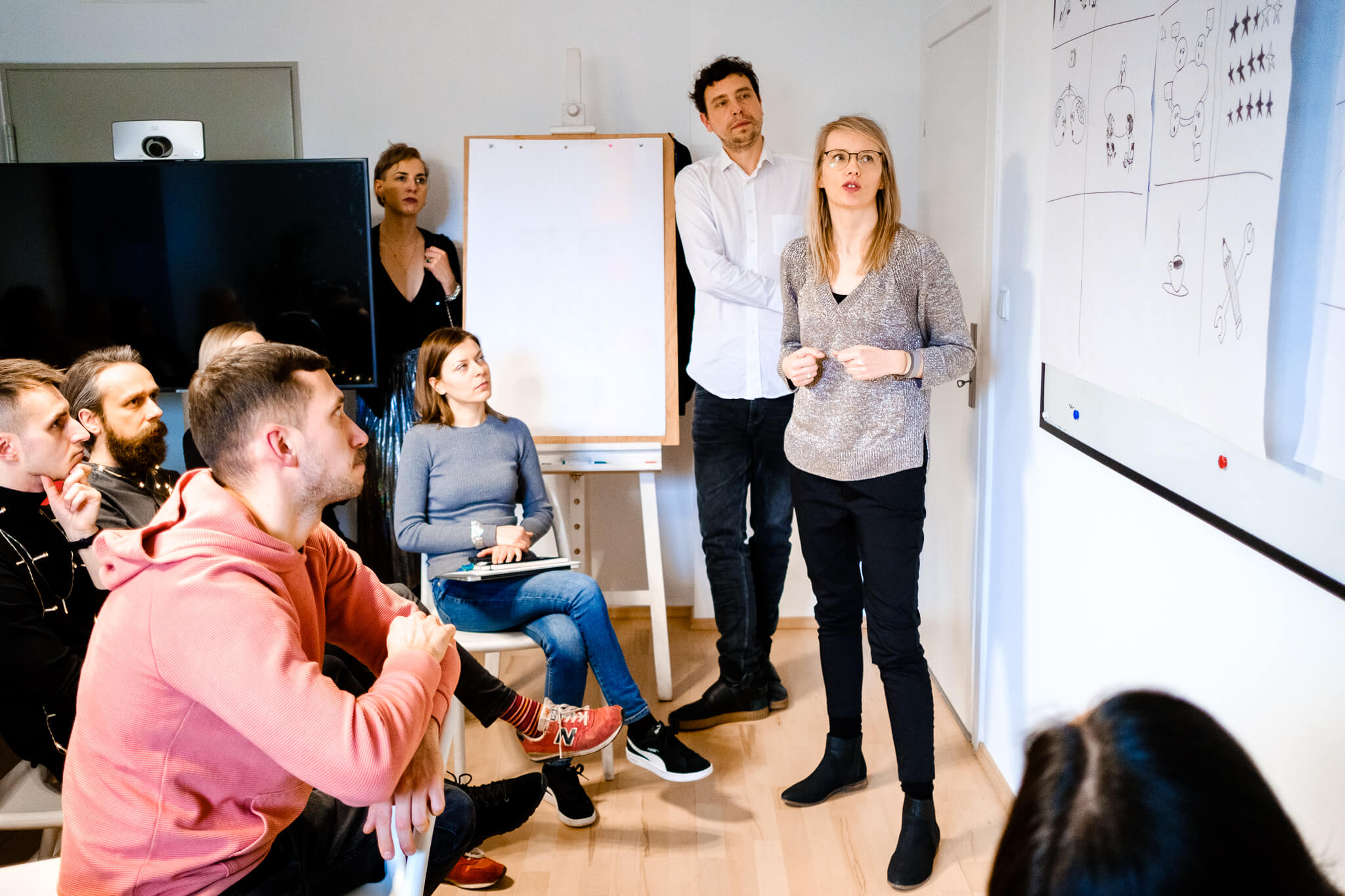
On a practical level, you can expect some specific documents or deliverables when you hire a business designer with a design background.
There are many efficient and stimulating tools to use in the business design process. Which one you choose depends on the context, the time available, the maturity of the organisation, and the experience of the Business Designer.
In our work, we often use some of the design thinking tools listed below:
- Market overview and benchmark of competitors or business models
- Scouting summary
- 2×2 matrices
- Research reports with insights and recommendations
- Protopersonas or Personas
- Customer journey maps
- Business model canvas
- Value Proposition canvas
- Service blueprint
- Product prototype
- Business model prototype
- Product prototypes
The value of the above deliverables is in the visualisation of complex processes and the presentation of different models to all stakeholders in the process.
It helps us to define the value of the product, identify the real needs of the consumers or users, to map the target groups, and the communication channels, or even project the expected revenues.
What is the difference between business design vs. user-centered design?
Business design and user-centred design have much in common as they are two different approaches to designing products, services, and experiences. However, while the typical designer focuses on the actual product or service and its value to the end user, the business designer extends this perspective to consider the profitability and market and economic potential of the business or its specific product.
Business design is a process that involves the creation and implementation of a profitable business. It involves identifying the target market, defining the products or services offered and determining the appropriate marketing and sales strategies to reach the desired audience. The focus of the business design is on creating a model that will help the business achieve its goals and be successful in the long term. It helps to match the needs of customers with the potential of the organisation.
User-centred design, on the other hand, is a design approach that focuses on creating products, services, and experiences that meet the needs and expectations of the end user. It involves conducting research to understand users’ needs, behaviours, and preferences, and using this information to shape the design of the product or service. The goal of user-centred design is to create a product or service that is intuitive, easy to use, and meets the user’s needs in a seamless and satisfying way.
Although the business design and user-centred design are separate approaches, they can often be used together in the development of products and services. By considering both business goals and user needs, companies can create products and services that are both effective and successful in the marketplace.
What is the difference between a business designer and a product designer?
A business designer and a product designer use similar tools, processes, and jargon. However, they are two different roles with different focuses and responsibilities.
A business designer is responsible for developing and implementing the overall strategy and plan for a business or business aspects of a product. This may include conducting market research and benchmarking to identify opportunities, and developing product or service offerings.
Business designers may also be responsible for identifying resources, such as human, technological and financial resources, to support the growth and success of the business. A business designer’s focus is on creating and implementing a high-level vision and models that will help the business achieve its goals and meet customer needs.
On the other hand, a product designer is responsible for designing specific physical or digital products with all their features. This may involve conceptualising and sketching ideas, creating prototypes and models, and testing and refining the design to ensure it meets the desired specifications and user needs. Product designers can work in a variety of industries, including consumer products, medical devices, automotive, and engineering. A product designer’s focus is on creating functional, aesthetically pleasing, and user-friendly products, and the outcome of their work consists of design deliverables (prototypes, layouts).
While business and product design are related and often use similar tools and methods, they are distinct fields with different focuses and expertise. Business designers are concerned with the overall strategy and plan for a business, while product designers focus on the design of specific products.
However, because business designers translate insights and needs into profitable business models, and product designers translate these into specific products and features, they very often work together on business design projects, especially during the prototyping phase when specific product design is required.
How to choose the right team and what competencies to look for?
Choosing the right team for a business design project is critical to the success of the project. When selecting team members, it is important to consider the specific skills and expertise required to successfully complete the project, as well as the personalities and working styles of the individuals. It’s also important to consider their previous experience and ability to deliver specific results.
Some key skills to look for when building a business design team are:
- Strategic thinking and problem-solving skills: The ability to analyse data and develop creative solutions to complex problems is essential for success in business design.
- Communication and collaboration skills: Business design often involves working with a diverse group of stakeholders, so strong communication and collaboration skills are essential.
- Industry knowledge and expertise: Team members with a deep understanding of the industry and target market can provide valuable insights and help inform the business plan. It is also helpful to recruit people with expertise from other industries who can suggest creative adoption of business models and solutions that have been used successfully in other sectors.
- Project management skills: Effective project management is critical to the success of a business design project, so team members with strong planning and organisational skills are important.
- Adaptability and flexibility: The business landscape is constantly changing, so team members who can adapt and pivot as needed will be valuable assets.
It can also be helpful to consider diversity when building a business design team, as a diverse team can bring different perspectives and experiences that can lead to more innovative and effective solutions. Include people with different levels of experience in the company (newcomers vs. veterans) and from different parts of the business (R&D, marketing, sales, customer support, HR, manufacturing, etc.).
How to weave business design philosophy into product development work?
Business design philosophy can be woven into product development work by aligning the product development process with the overall goals of the business.
This can be achieved by incorporating some of the following steps into the product development process:
- Clearly define the business objectives and the target market: Understand the overall goals of the business and the needs and preferences of the target market.
- Conduct market research: Gather and analyse data on competitors, industry trends, and customer needs, which can help to create the right mindset and business models.
- Define product vision and roadmap: Develop a clear product vision and roadmap to ensure that the product development process is aligned with business goals and that resources are allocated effectively.
- Incorporate human-centred design principles: By considering the needs and expectations of the end user throughout the product development process, companies can create products that are intuitive, easy to use, and meet people’s needs.
- Monitor and adjust the product roadmap: Regularly review and update the product plan in light of market trends and customer feedback to ensure that the product remains relevant and competitive.
Weaving the business design philosophy into the product development work means aligning the product development process with the overall strategy of the organisation and considering the needs and expectations of the end user throughout the process.
What is the role of qualitative research and various UX studies in the process of business design?
Qualitative research and various UX (user experience) studies can play an important role in the business design process by providing valuable insights into the needs, behaviours, and preferences of different types, groups, and segments of customers.
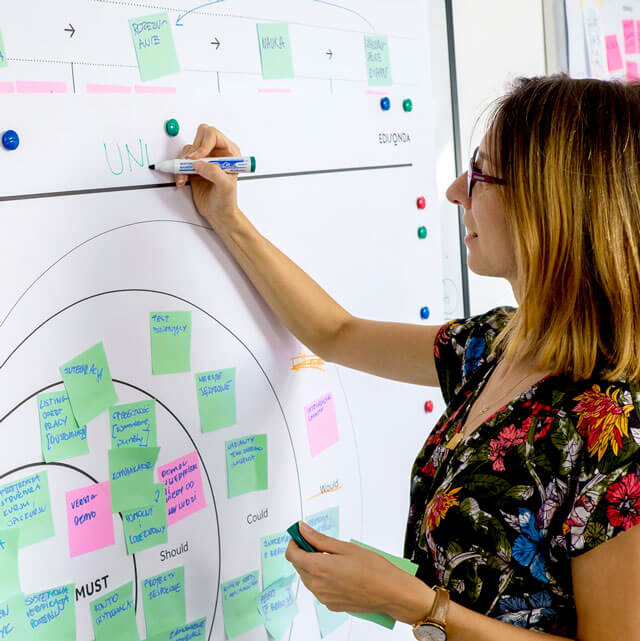
This information can be used to create personas that help all team members avoid biases and assumptions based on their context and experience.
Qualitative research involves gathering data through methods such as in-depth interviews, focus groups, and observations, and analysing it to identify patterns and themes. It can provide a deeper understanding of customers and their motivations, which can be particularly useful in the early stages of business design when defining the product, target market, and value proposition.
UX studies, such as usability testing and user research, can also provide valuable insights into the user experience of products and services. By understanding how users interact with and feel about a product or service, companies can identify areas for improvement and create a more enjoyable and effective user experience.
In the validation phase, it is helpful to conduct user testing of prototypes or RITE studies to ensure that the developed prototype meets the needs of customers and to reduce the risk of launching a product that is not understood, accepted, adopted, or needed.
Qualitative research and UX studies can help companies better understand the needs and preferences of their customers and create better products and services.
How is platform thinking connected with business design?
Platform thinking is a mindset and approach to business that involves creating a platform – a foundation or infrastructure – on which other businesses or organisations can build and operate, or by providing and controlling a complete ecosystem that caters to a holistic customer experience. A platform can be physical or digital and can be used to facilitate the exchange of goods, services, or information between different parties.
Platform thinking is closely related to business design, as it involves designing a business model that enables the creation and operation of a platform. This may involve identifying the target market and value proposition, defining the products or services to be offered, and determining the appropriate pricing and revenue model. It also involves creating a sustainable business model that can support the growth and success of the platform and the ecosystem of products and services over time.
Platform thinking can be particularly useful for companies that want to create a new market or disrupt an existing one. By designing a platform that enables the creation and operation of new businesses or services, companies can unlock new sources of value and drive innovation as well as build long-term loyalty of their customers.
How to start learning about business design?
Business design is a bit like preparing a meal. At first glance, it looks like anyone can do it, but to become a world-class chef you need a combination of talent and a huge amount of experience that comes from cooking and getting your hands dirty.
It requires a genuine interest in the business world, a good sense of observation and first-hand experience of projects where products and business models have been built. But to avoid the vicious circle of “to gain experience, you have to have it”, it’s a good idea to start by reading and learning from experts as a team member.
Depending on your specific interests and goals, there are several ways to get started. Here are some suggestions:
- Read books and articles about business design: Many books and articles available online introduce business design principles and techniques. Reading these can be a good way to gain a basic understanding of the subject, equip yourself with the lingo, and build the first version of the mental models.
- Read business magazines and newspapers to learn the language of business and to get to know different business models and different moments in the life of organisations (launch, scaling, acquisition, mergers, etc.).
- Attend online courses or workshops: Online courses and workshops can provide a more structured learning experience, with interactive lessons and exercises to help you apply what you have learned.
- Join a professional organisation or network: These can provide access to resources and events related to business design, as well as opportunities to network with other professionals in the field.
- Get hands-on experience: Experience is often the best teacher, so look for opportunities to work on business design projects or internships to gain practical experience. NGOs can also be an interesting first client.
- Find a mentor or coach: Working with a mentor or coach who has experience in business design can be a valuable way to learn from someone who has “been there, done that” and can provide guidance and support.
- Join a consultancy where you can be part of the team and learn from more experienced colleagues by having access to different clients. While working with a specific product allows you to understand a business from many different angles, working as a consultant gives you the unique opportunity to get to know dozens of businesses over the course of a year and gain this valuable meta-perspective.
While none of these tips will make you an instantly a business designer, mixing them up and experimenting with different approaches can help you find what works best for you. With a bit of patience and insatiable curiosity, you should be able to develop the specific skills and mindset required for business design.
What are the best books to read on business design?
As a starting point, we’ve compiled a list of several books on business design published in recent years, covering strategy, philosophy, and practical approaches to business design.
- “Blue Ocean Strategy: How to Create Uncontested Market Space and Make the Competition Irrelevant” by W. Chan Kim and Renée Mauborgne
- “The Lean Product Playbook: How to Innovate with Minimum Viable Products and Rapid Customer Feedback” by Dan Olsen
- “Scaling Lean: Mastering the Key Metrics for Startup Growth” by Ash Maurya
- “The Lean Enterprise: How Corporations Can Innovate Like Startups” by Owens Trevor
- “The Lean Startup: How Constant Innovation Creates Radically Successful Businesses” by Eric Ries
- “Business Model Generation: A Handbook for Visionaries, Game Changers, and Challengers” by Alexander Osterwalder and Yves Pigneur
- “The Business Model Navigator: 55 Models That Will Revolutionize Your Business” by Oliver Gassmann, Karolin Frankenberger, and Michaela Csik.
- “The Innovator’s Dilemma: When New Technologies Cause Great Firms to Fail” by Clayton M. Christensen
- “The Fifth Discipline: The Art and Practice of the Learning Organization” by Peter M. Senge
- “The Outsiders: Eight Unconventional CEOs and Their Radically Rational Blueprint for Success” by William N. Thorndike
- “The Design of Business: Why Design Thinking Is the Next Competitive Advantage” by Roger L. Martin
- “The Design Thinking Playbook” by Michael Lewrick, Patrick Link, and Larry Leifer
- “Designing for Growth” by Jeanne Liedtka and Tim Ogilvie
- “Value Proposition Design” by Alexander Osterwalder
Reach out to us if you would like to discuss your business design challenges or ideas for new products or businesses.
